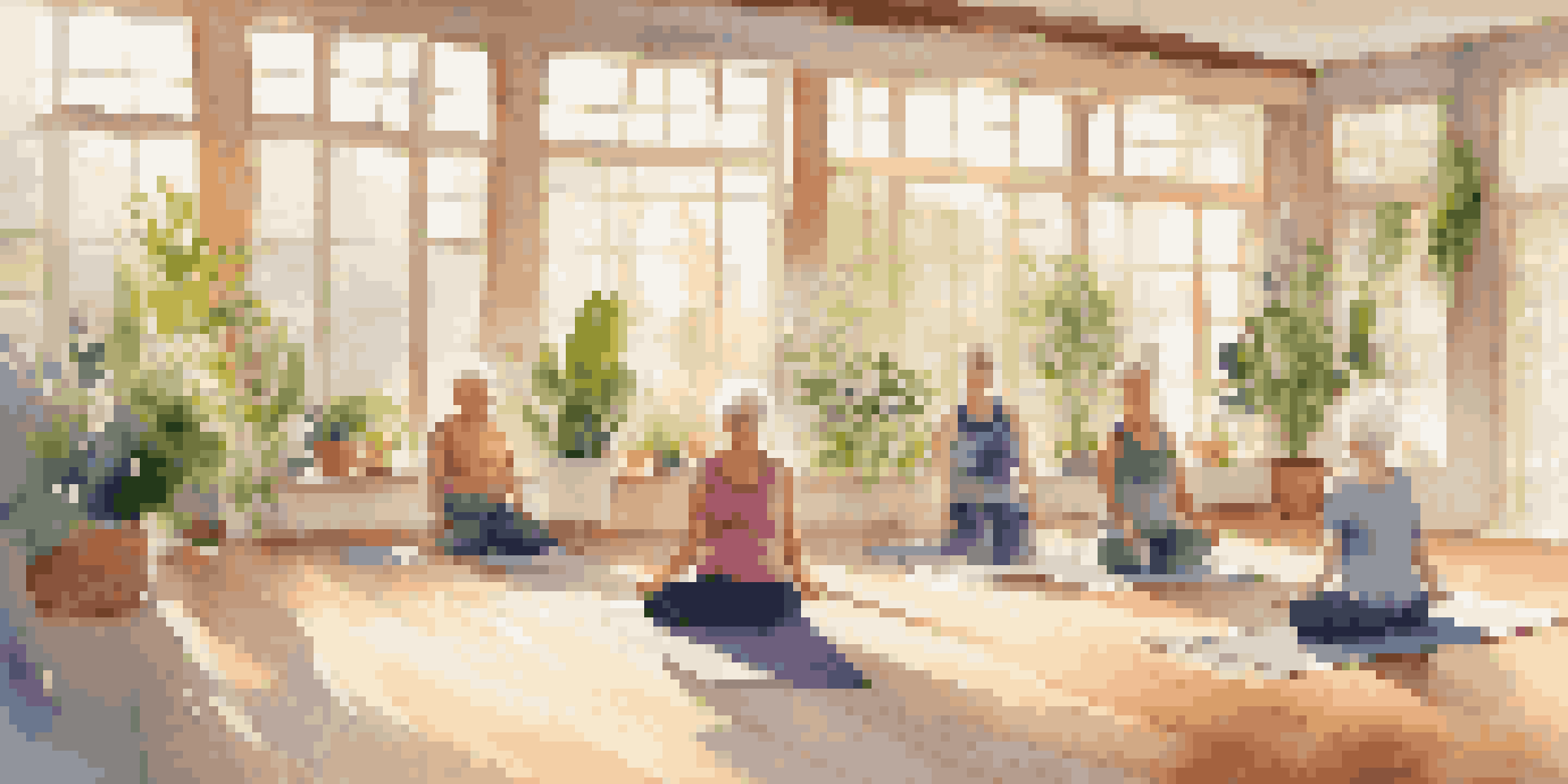How Yoga Supports Healthy Aging and Physical Wellness

The Basics: What is Yoga and Its Importance?
Yoga is an ancient practice that combines physical postures, breathing techniques, and meditation. It’s not just about bending and stretching; it’s a holistic approach to wellness. For seniors, understanding yoga's fundamentals can open the door to a healthier lifestyle.
Yoga is the journey of the self, through the self, to the self.
The importance of yoga lies in its ability to promote flexibility, strength, and balance. These elements are crucial as we age because they help reduce the risk of falls and injuries. The more we practice, the more our bodies adapt and respond positively.
Moreover, yoga encourages mindfulness, helping practitioners become more aware of their bodies and emotions. This awareness can lead to better decision-making around health and wellness, making yoga a vital tool for anyone looking to age gracefully.
Physical Benefits of Yoga for Aging Bodies
As we age, our bodies naturally lose muscle mass and flexibility. Yoga counteracts these changes by promoting muscle strength and joint flexibility. Poses like downward dog and warrior can help strengthen the legs and core, making daily activities easier.

Additionally, yoga can improve balance, which is particularly important for older adults. Practicing poses that require balance, such as tree pose, helps enhance stability and coordination. This can drastically reduce the chance of falls, which are a common concern among seniors.
Regular practice can also alleviate chronic pain conditions like arthritis or back pain. Gentle stretches can ease tension and promote relaxation, making it a fantastic option for those seeking relief from discomfort.
Mental Wellness: Yoga's Role in Emotional Health
Yoga isn't just about physical benefits; it significantly impacts mental wellness too. The practice encourages relaxation and reduces stress, which can be particularly beneficial as we navigate life’s transitions during aging. A calm mind is crucial for overall health.
The body is your temple. Keep it pure and clean for the soul to reside in.
Engaging in yoga can also enhance mood and emotional resilience. The combination of movement and mindful breathing releases endorphins, the body’s natural feel-good hormones. This boost in mood can help combat feelings of anxiety or depression often associated with aging.
Incorporating mindfulness into your yoga practice can lead to a deeper sense of connection with oneself. This self-awareness fosters a positive outlook on life, allowing individuals to embrace aging rather than fear it.
Building Community Through Yoga Practices
Yoga is often practiced in group settings, which can foster a sense of community and belonging. For seniors, participating in a yoga class can be a social outlet, reducing feelings of loneliness and isolation. These connections can make a significant difference in one’s quality of life.
Sharing yoga experiences or simply practicing alongside others creates a supportive environment. This camaraderie encourages individuals to stick with their practice, which is vital for reaping the long-term benefits of yoga.
Furthermore, community yoga classes often cater to various skill levels, making it accessible for everyone. This inclusiveness allows older adults to find a space where they feel welcomed and valued.
Adapting Yoga Practices for Individual Needs
One of the great things about yoga is its adaptability. Whether you are a beginner or have some experience, yoga can be tailored to fit individual needs and abilities. Modifications can make poses more accessible, ensuring everyone can participate safely.
For seniors with limited mobility, chair yoga is a fantastic option. It allows individuals to experience the benefits of yoga while seated, making it easier to maintain strength and flexibility without risking injury.
Always listen to your body and consult with a healthcare provider if new to yoga or have specific health concerns. This approach ensures a safe and effective practice, empowering individuals to take charge of their wellness journey.
Breath: The Foundation of Yoga and Wellness
Breathing is a core aspect of yoga practice, often referred to as 'pranayama.' Proper breathing techniques can enhance physical performance and lower stress levels. Learning to control breath can lead to a deeper sense of relaxation and focus.
As we age, our lung capacity may decrease, making effective breathing even more essential. Yoga encourages deep, conscious breathing, which can improve lung function and overall respiratory health.
Incorporating breathwork into daily life can also help manage anxiety and improve emotional well-being. A few minutes of focused breathing can make a big difference, especially during stressful situations.
Creating a Sustainable Yoga Routine at Home
While attending classes is beneficial, establishing a home yoga routine can enhance the practice even further. Setting aside specific times for yoga can help create a consistent habit, which is key to experiencing its full benefits. Start small with just a few minutes each day.
Utilizing online resources or yoga apps can provide guidance and inspiration for home practice. These tools often offer classes tailored to different levels, making it easier to find routines that suit your needs.

Creating a dedicated space for yoga at home can also enhance the experience. A peaceful corner with a mat and some calming decor can make your practice feel special and inviting, encouraging regular engagement.